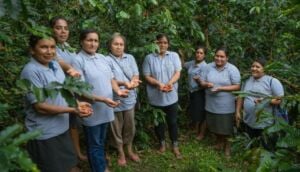Herbert Smorenburg, Senior Manager Netherlands Office, Global Alliance for Improved Nutrition
The IFC estimates that the 4.5 billion people at the “base of the pyramid” (BoP) spend $2.3 trillion a year on food and beverages. Even farmers are net purchasers of foods, particularly during the lean season before the next crop is harvested. Yet, this analysis is often missing when we talk about tackling malnutrition.
The reality is that most people use markets to access most of their foods, most of the time. However, the lack of affordable nutritious offerings in the market place, compared to the wide availability of food and beverages that have a detrimental effect on nutrition and health, indicates that currently the poorest customers are not well served by markets.
To meet this need the Amsterdam Initiative Against Malnutrition (AIM), a joint public-private-partnership founded by the Ministry of Foreign Affairs of the Government of the Netherlands, GAIN, Unilever, DSM, AkzoNobel, Wageningen University, and ICCO Cooperation, designs innovative social business ideas and sustainable solutions with a market-based approach. AIM brings together about 30 partners, following the model of the so-called “Dutch diamond”, a form of multi-stakeholder partnership that joins forces and expertise from government (with subsidies and policy directions), businesses (funds, R&D, marketing and distribution), knowledge institutes (nutrition, M&E and knowledge management) and civil society organizations (local networks, lobby and advocacy, awareness campaigns).
AIM supports innovative business models that improve supply and access to affordable nutritious products. This market-based approach has several advantages as it can lead to product innovation, value chain optimization and the use of locally produced ingredients. The target groups are BoP consumers who make their own decisions based on good information. Local partners take the lead in all projects to ensure they are sustainable.
AIM shows that creating markets for nutritious foods depends on an approach that covers the entire value chain, from seed to stomach. As such, AIM projects focus on some of the key aspects that contribute to creating an enabling environment:
– Incentives for farmers to grow nutritious crops: These can include predictable markets, greater access to storage and processing facilities to protect perishable crops like fruits and vegetable and greater access to market information such as crop prices.
– Access to finance: Investments are needed to scale up the ideas that have the largest impact on nutrition security. As financial sustainability is of major importance to all projects, special attention must be given to improving access to finance for local entrepreneurs.
– Distribution systems that reach different population groups with varying nutritional needs, preferences and purchasing power. For the landless and non-farming communities local markets, formal markets, food vendors and public food distribution systems are the sources of day-to-day sustenance. For populations living in hard to reach rural areas where nutritious food is not available, community distribution models, which harness informal community networks, can increase access. Some of the most successful distribution models now combine public resources and distribution networks with market-based approaches.
– Demand creation: Understanding what motivates consumer behaviour helps to create new products and brands which are more easily accepted by the consumer. Demand creation can be supported by flexible pricing models for nutritious foods as well as improved public awareness and understanding of nutrition and health.
– Quality control and assurance: Establishing and enforcing robust regulatory frameworks is a huge challenge in developing countries where a significant amount of food is unbranded and unpackaged. Farmers and producers need support to comply with hygiene, safety and quality standards in order to be able to supply food to local and regional markets. Building brands that are reliable, safe and trustworthy will help consumers to make healthy decisions.
These are just some of the enabling conditions. On a broader basis, a primary role is played by local and national governments who enable market activities with laws and regulations, the existence of democratic institutions and by tackling corruption.
To give a concrete example, let’s look a bit deeper into one of our AIM projects.
In South Africa, SPAR, a major international retailer, is working with a range of partners to create Rural Retail Hubs; to support greater access to nutritious products amongst local communities, and in the process, creating a predictable market for local farmers growing nutritious foods. The project combines demand creation through awareness campaigns targeting BoP consumers with support for farmers, ranging from access to capital, education on business models and training on farming practices to develop skills and opportunities. The farmers are encouraged to form cooperatives to make decisions on what to produce and in what quantities, supported with access to high quality seeds and a distribution network that takes the fresh produce to supermarkets across the region.
Initially, there were reservations over whether the project would be able to achieve the necessary scale to ensure that the retail hubs became commercially viable. As a result, three decentralized Fresh Produce Assembly points will be established to take care of the packaging and cooling of local fresh produce, which will then be supplied to a number of SPAR retail shops in the area. Through this local co-creation approach a challenge was turned into a new opportunity. The farmers will work in partnership with the retail selling channel of SPAR whose network of independent retailers will ensure the market for farmers and provide consumers with safe food.
Every sector has a role to play in extending access to and building demand for nutritious foods. For example, as food production becomes more integrated in to value chains, businesses can engage, educate and incentivise suppliers, distributors and retailers in their supply chains to sell nutritious products and promote good nutritional practices.
Going forward, to strengthen markets for nutrition we need to build a much deeper understanding of how markets are working, where people are sourcing their food from, the choices that individuals and households make and the factors that influence those choices. Projects like Rural Retail Hubs provide valuable insights about what works and how we can take projects to scale.










